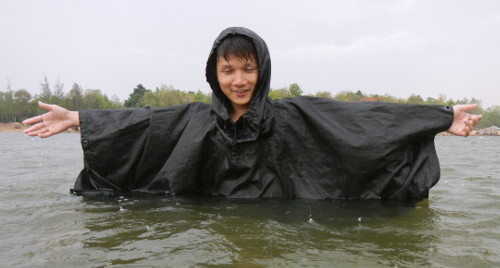Poncho Swimming
Army ponchos come in really useful on amphibian wilderness treks through wetlands or rain forests. The robust fabric protects you as you move through wet vegetation, muddy wetlands, or swim in open water.
For treks like these you have to be able to swim fully clothed with a poncho on top.
You won't be hiking in just a poncho.
Wear quick drying clothes under your poncho.
We recommend thin but robust cargo pants, a thermal top, and maybe a fleece hoodie.
The poncho will protect you and your clothes from many perils.
Now it is time to practice swimming.
Pool Training
Learn to swim in your poncho. It is easy and good fun. We recommend regular training to keep you fit. Find a local pool where you may swim in clothes. Not an easy task. Tell them that you are a proficient swimmer and that you use only man-made fibres that won't clog up their filter systems.
When you arrive, change into your swimming clothes, but don't put on your poncho just yet. For hygiene reasons take a shower until all your clothes a soaking wet and well rinsed. Then go to the pool and put your poncho on. Initially swim in shorts and swim-shirt under your poncho, later add a tracksuit.
Army ponchos often have a waist band inside the front to keep it close to your body when you wear it in the water. Use it so that only the lower part of your poncho floats about, but it can't cover your face.
Wade in carefully and control how your poncho floats.
As you move, it closely hugs your body and thus keeps out of the way.
Now swim as many lengths as you can and count them.
The more often you train the more lengths you want to swim to really fit for the great outdoors.
Lake Experience
Now comes to good bit. Find a calm lake or shallow beach where you can wade in safely. Pick clothes for the water temperature, not the warm air. You'll spend more time in the water, or walking in wet clothes which may chill you out as the water evaporates.
One of the poncho's benefits is that it slows the evaporation cooling and protects you from wind chill. Yet it has better ventilation than rain suits when you wear it loose.
Put on all your hiking clothes and shoes. Make sure they fit well. Throw your poncho over and tie the waist band. Now you're ready to get wet.
Time To Get Wet
Wade into the water carefully and control how your poncho floats. Mind your step. Watch how the water enters your shoes, soakes your trousers and reaches your poncho. Notice how the drag of the clothes increases while the weight on your feet diminishes.
As you move, your poncho closely hugs your body and thus keeps out of the way. When you sit still in the water it floats around your body as a shelter and keeps some warmth in, especially if you wear clothes underneath.
When you're about neck deep, all your clothes are wet and should feel good. Check for any discomfort that you may want to adjust later. Now lean forward and start swimming.
Hood Test
Put the hood up and duck under. Does it fit well when you come up again? It should not limit your vision. It may also stick to your ears so won't hear well for a moment. Just shake your head.
Next float on your backside with your head in the water and the hood up.
It should cover your head and not come loose or float around.
This feels very relaxing.
Enjoy!
Distance Swimming and Trek Simulation
This is where your pool training comes in and makes it easier. Swim along the shore dressed in your full hiking kit. Whenever possible, get out of the water at a suitable spot and run or walk a bit, maybe through woodland.
Go back into the water and swim a fair distance. This simulates a wetland hike through unknown terrain. Whenever you like, sit in shallow water and relax. Watch if your clothes chafe. Make sure they feel good in the water.
